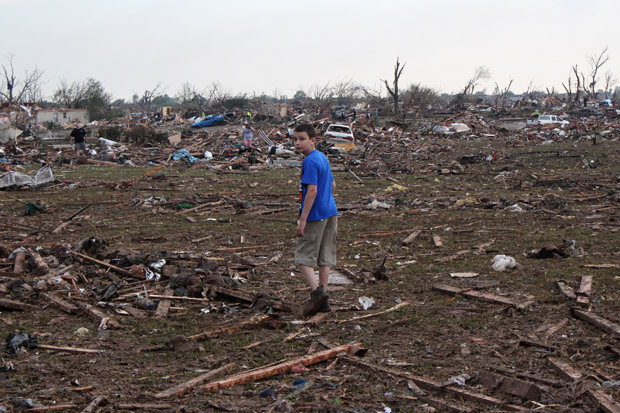Why Oklahoma’s Priority is Storm Shelters for Individuals, Not Safe Rooms for Schools
-
Logan Layden

Joe Wertz / StateImpact Oklahoma
Eleven-year-old Gavin Hawkins stands near the rubble of the Plaza Tower Elementary School. His dad, Joel, rushed to the school to pick up his son before the storm hit.
Seven children were killed at an elementary school in Moore when a massive tornado tore through the area last month.
And the disaster has led to questions about why Oklahoma used previous federal disaster money to build more than 10,000 storm shelters in homes, but only 85 in public schools.
Getting the answer means going back to another major storm, on May 3, 1999, and another state.
After the 1999 storm, then-President Bill Clinton came to Del City to tour tornado damage, and called for more safe rooms. It didn’t take long for Albert Ashwood and the Oklahoma Department of Emergency Management to respond.
“So that afternoon, after he left, we sat down — our office, FEMA, the Small Business Administration — and said, “How do we make safe rooms happen for individuals? How can we make that something that people can take advantage of?” Ashwood recalls.
Historically FEMA had never allowed disaster mitigation aid to be spent on safe rooms. That changed after the 1999 tornado outbreak. The Oklahoma Department of Emergency Management and then-Gov. Frank Keating put the focus on individual shelters.
But the outbreak didn’t just affect Oklahoma. Next door in Kansas, where tornadoes also struck that day, state leaders came to a different conclusion. Sharon Watson, with the Kansas Division of Emergency Management, says they’ve spent most of their mitigation money on school shelters.

Logan Layden / StateImpact Oklahoma
Oklahoma Department of Emergency Management Director Albert Ashwood in the agency's command center.
“In 1999, a tornado hit Haysville and Wichita, and Haysville is south of Wichita, and it damaged some schools in both of those communities,” Watson says. “At the time, school was out, so all the children were home for the evening. Even though the schools were damaged, there weren’t any injuries to the children. But it did get individuals in those communities looking into funding safe rooms and how to go about that.”
The same tornado outbreak. On the same day. Two different reactions.
Where Oklahoma’s tornado destroyed practically everything in its path, mainly homes, damage to schools got the big headlines after the Wichita storm. In the end, how to handle the money — whether it goes toward a rebate program for individuals, or is earmarked for school and community shelters, or both — is up to states. And Ashwood says there are other disasters Oklahoma has to be ready for.
“We’ve bought out houses in flood plains to move people out so they don’t flood anymore. We’ve had drainage projects. We’ve had retention ponds. We’ve had a bunch of different mitigation projects that aren’t just safe room,” Ashwood says.
And that’s how it can be that Kansas, despite having fewer disaster declarations since 1999, and fewer disaster mitigation dollars, built twice the number of school safe rooms.
Ashwood says school shelters have become a bigger priority, and Oklahoma did build 85 with federal help. But he thinks an emphasis on individual shelters can save more lives, and state policy reflects that belief.
“Most of them don’t hit during school hours. Most of the time, people have actually gone home,” Ashwood says. “So, yeah, we’ve probably put a little more emphasis on people when they get home, do they have a safe place to go?”
